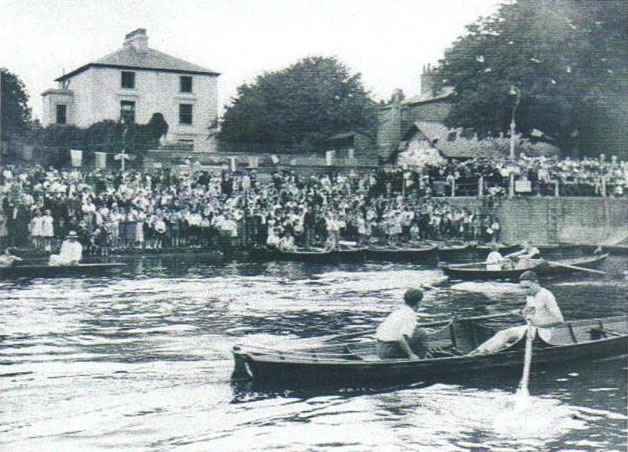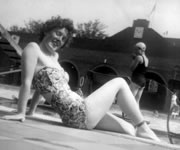Charlie Shore - The Man & His Regatta
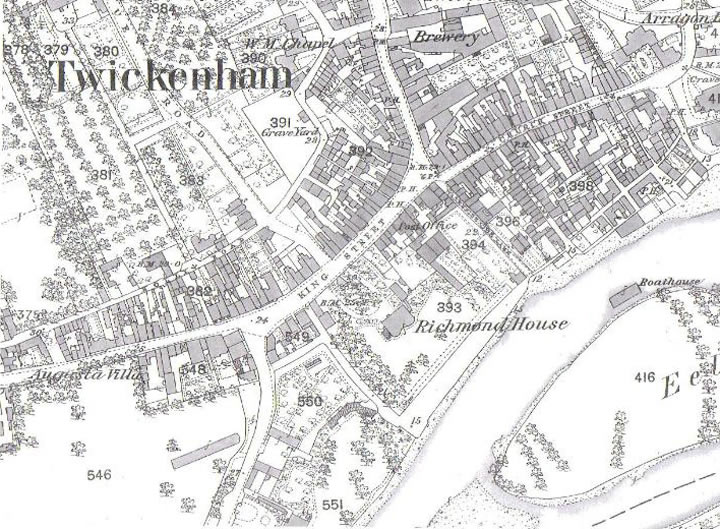
Biographical details. Charles William Shore, always known as “Charlie”, was a Twickenham man born and bred, living and working within a stone’s throw of the Embankment all his life. He was born on 3 March 1858 in Bell Lane, to William (who had been born in Back Lane – now Holly Road) and Mary Ann (nee West). William was a coal porter and labourer, but young Charlie preferred the water. He was apprenticed to his uncle, the waterman Edward Hammerton from Water Lane in 1873, being thereby “bound” until 1881 (Edward is from the same family as Walter Hammerton, who in 1909 started the ferry between Ham and.Marble Hill).
However, his uncle died in 1876 before the prescribed term was complete, and Charlie was reassigned to another master, James Richard Moffatt (who had been a next door neighbour when the family lived in Bell Lane in 1871), until April 1877. Thus, Charlie was able to give his occupation as “waterman” in 1881, at which time he was living with his aunt Ellen Hammerton (widow of Joseph Hammerton and the late Edward’s sister-in-law, who had previously been the latter's housekeeper); his cousin Julia George, a dressmaker, was living in the same house. In 1883, Charlie and Julia were married at St Anne’s, Islington, and settled at Rose Cottage, Water Lane; three children followed, William Charles (who died aged 6), Annie Florence (b 1889)and Charles jnr (b 1891).
(In the 1881 Census, Charlie and Julia were described as “nephew” and “niece” respectively of Ellen Hammerton. This would mean they were cousins; however, I can trace no consanguinity. Edward and Joseph Hammerton were brothers, who both lived in Water Lane and Waterside; Edward (1800-1867) married Jane née Brett (1809-1870), Joseph (1804-1860) married Ellen née White (1807-1881). Julia's parents were William John George (a coachpainter) and Mary Ann née Burdett, and Charlie's (as already stated) William Shore and Mary Ann née West. There are no recorded marriages between Hammerton and George between 1800 and 1850. It is possible that “nephew” and “niece” are used in the 1881 Census return with the archaic meaning of “any male/female descendant” (Chambers Dictionary).
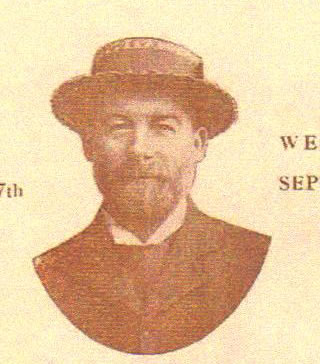 An extremely important event for all watermen in the Twickenham area took place in 1894: the Richmond Half-Tide Lock and Weir was completed. This meant that the river became semi-tidal and thus navigable at all times, whereas previously at low tide there was often little but mud. This obviously had a dramatic effect on the stretch of water known locally as “Horse Reach” (between Syon Reach and Cross Deep) plied by Charlie and his colleagues. A report in a local newspaper of a Twickenham Regatta in August of that year reads “Last year's unsightly mudbanks and tidal difficulties were left conspicuous only by their absence, and there was plenty of water right over the course at all periods”.
An extremely important event for all watermen in the Twickenham area took place in 1894: the Richmond Half-Tide Lock and Weir was completed. This meant that the river became semi-tidal and thus navigable at all times, whereas previously at low tide there was often little but mud. This obviously had a dramatic effect on the stretch of water known locally as “Horse Reach” (between Syon Reach and Cross Deep) plied by Charlie and his colleagues. A report in a local newspaper of a Twickenham Regatta in August of that year reads “Last year's unsightly mudbanks and tidal difficulties were left conspicuous only by their absence, and there was plenty of water right over the course at all periods”.
In 1901 Charlie described his occupation as “boat builder”, and he employed at least one assistant. His boathouse occupied a prominent position on The Embankment, very close to where the bridge to Eel Pie Island is today (see photograph). In 1906, keeping it in the family, he bound his son Charles as an apprentice, so that by 1911 the latter too could call himself “waterman”. (Charles jnr subsequently in his turn took on apprentices, John Thomas Spong in 1913 and Charles Henry Smith in 1915). The family was now living in a seven room house, River View on The Embankment, but had no live-in servants.
Charlie collapsed and died of a cerebral haemorrhage while attending to his boats on April 11 1912. His passing and his funeral were noted by generous amounts of comment in local newspapers (see below). His estate amounted to £209 (equivalent to about £19,300 in today’s money).
Extracts from obituary notices. From Thames Valley Times, 12 April 1912 (just one day after his death): “Than Charlie Shore was probably no better known man in Twickenham among all classes of the community…….Charlies’ fame was not confined to Twickenham; he was known up and down the river for miles…..A man of large heart, he was ever ready to do a good deed wherever he could……. His love of children was a real one, and to see him on a summer morning surrounded by scores of boys and girls anxious to use his boats to practice in, was a sight worth beholding”. His funeral, held on 15 April, was reported in detail in the issue of 19 April.
From Richmond and Twickenham Times, 29 April 1912: “His simplicity, natural generosity and kindly spirit were always present to those in every class of those who came in touch with him. But to none did he shine so brightly as to the “little kiddies” and they would remember the familiar face”
Charlie's legacy: the Children’s Regatta. There was local abundance of regattas during the 1890s, so much so that an Editorial in a local paper drew attention to the inconvenience for residents in being solicited for contributions for three Regattas during the months of August and September 1895. For example, during a period of four weeks in the summer of 1894 there were: Police Regatta, Twickenham Regatta, Railway Rowing Club Regatta and Twickenham Working Mens' Boating Club Regatta, in all of which Charlie had a hand . However, all this action was for the benefit of adult rowers, and so Charlie decided in 1894 to stage a children’s regatta. This turned into a tremendous success, many local schools taking part, with bands, prizes and fireworks, and it became an annual event. Following Charlie's sudden death, his wife and Charles jnr took on the running of the event, and it continued throughout WW1.
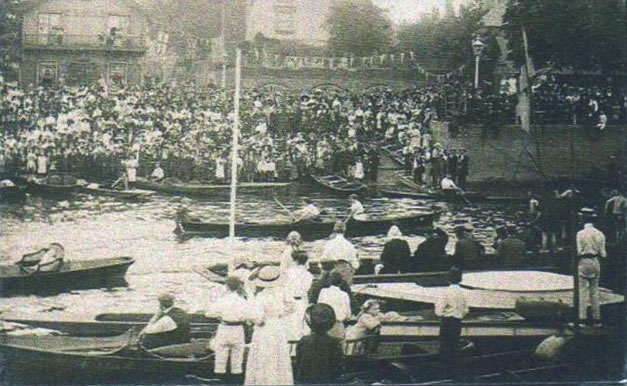
The popularity of the regatta can be judged from the way it was reported by the local Press; for example, in September 8th 1937, the Thames Valley Times devoted a 9 inch column to “One of the big events of the year, the Boys’ and Girls’ Regatta”, going on to describe “dinners and teas at The Fox, prize-giving (15 cups and one shield) by the Mayor and Mayoress and fireworks at 9.30”.
In 1926 a major redevelopment of King St and Water Lane occurred, and at this time Charlie jnr sold the Boathouse to Hammertons and with his family moved away from Twickenham. The Boathouse remained in use for boat building during the years preceding WW2: in 1936 and 1937 it was occupied by Thames Craft Manufacturing Ltd, and in 1939 and 1940 by Ray Craft Ltd. It seems likely that it was damaged in 1944 by the V1 flying bomb that destroyed the nearby Gotham Villas (situated at the town end of Water Lane) and killed several local residents, including Fred Hammerton.
Despite the departure of Charles jnr, the annual Regatta continued with local support until just before the outbreak of WW2. Efforts to repeat its success after the war were only partly successful, and it was discontinued during the 1950s; however, the event has recently been revived, and it seems set to remain a popular attraction for years to come.
